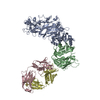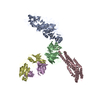[English] 日本語
 Yorodumi
Yorodumi- EMDB-16570: PfCyRPA-PfRIPR complex from Plasmodium falciparum bound to antibo... -
+ Open data
Open data
- Basic information
Basic information
| Entry |  | |||||||||
|---|---|---|---|---|---|---|---|---|---|---|
| Title | PfCyRPA-PfRIPR complex from Plasmodium falciparum bound to antibody Cy.003 | |||||||||
 Map data Map data | composite map | |||||||||
 Sample Sample |
| |||||||||
 Keywords Keywords |  Plasmodium falciparum / erythrocyte-invasion / PfRCR / blood stage malaria vaccine / Plasmodium falciparum / erythrocyte-invasion / PfRCR / blood stage malaria vaccine /  CELL ADHESION CELL ADHESION | |||||||||
| Function / homology |  Function and homology information Function and homology informationmicroneme lumen /  microneme / symbiont entry into host / host cell membrane / apical part of cell / cytoplasmic vesicle / host extracellular space / host cell plasma membrane / protein-containing complex / extracellular region ...microneme lumen / microneme / symbiont entry into host / host cell membrane / apical part of cell / cytoplasmic vesicle / host extracellular space / host cell plasma membrane / protein-containing complex / extracellular region ...microneme lumen /  microneme / symbiont entry into host / host cell membrane / apical part of cell / cytoplasmic vesicle / host extracellular space / host cell plasma membrane / protein-containing complex / extracellular region / microneme / symbiont entry into host / host cell membrane / apical part of cell / cytoplasmic vesicle / host extracellular space / host cell plasma membrane / protein-containing complex / extracellular region /  membrane / membrane /  plasma membrane plasma membraneSimilarity search - Function | |||||||||
| Biological species |   Plasmodium falciparum 3D7 (eukaryote) / Plasmodium falciparum 3D7 (eukaryote) /   Gallus gallus (chicken) Gallus gallus (chicken) | |||||||||
| Method |  single particle reconstruction / single particle reconstruction /  cryo EM / Resolution: 3.1 Å cryo EM / Resolution: 3.1 Å | |||||||||
 Authors Authors | Farrell B / Higgins MK | |||||||||
| Funding support |  United Kingdom, 1 items United Kingdom, 1 items
| |||||||||
 Citation Citation |  Journal: Nature / Year: 2024 Journal: Nature / Year: 2024Title: The PfRCR complex bridges malaria parasite and erythrocyte during invasion. Authors: Brendan Farrell / Nawsad Alam / Melissa N Hart / Abhishek Jamwal / Robert J Ragotte / Hannah Walters-Morgan / Simon J Draper / Ellen Knuepfer / Matthew K Higgins /  Abstract: The symptoms of malaria occur during the blood stage of infection, when parasites invade and replicate within human erythrocytes. The PfPCRCR complex, containing PfRH5 (refs. ), PfCyRPA, PfRIPR, ...The symptoms of malaria occur during the blood stage of infection, when parasites invade and replicate within human erythrocytes. The PfPCRCR complex, containing PfRH5 (refs. ), PfCyRPA, PfRIPR, PfCSS and PfPTRAMP, is essential for erythrocyte invasion by the deadliest human malaria parasite, Plasmodium falciparum. Invasion can be prevented by antibodies or nanobodies against each of these conserved proteins, making them the leading blood-stage malaria vaccine candidates. However, little is known about how PfPCRCR functions during invasion. Here we present the structure of the PfRCR complex, containing PfRH5, PfCyRPA and PfRIPR, determined by cryogenic-electron microscopy. We test the hypothesis that PfRH5 opens to insert into the membrane, instead showing that a rigid, disulfide-locked PfRH5 can mediate efficient erythrocyte invasion. We show, through modelling and an erythrocyte-binding assay, that PfCyRPA-binding antibodies neutralize invasion through a steric mechanism. We determine the structure of PfRIPR, showing that it consists of an ordered, multidomain core flexibly linked to an elongated tail. We also show that the elongated tail of PfRIPR, which is the target of growth-neutralizing antibodies, binds to the PfCSS-PfPTRAMP complex on the parasite membrane. A modular PfRIPR is therefore linked to the merozoite membrane through an elongated tail, and its structured core presents PfCyRPA and PfRH5 to interact with erythrocyte receptors. This provides fresh insight into the molecular mechanism of erythrocyte invasion and opens the way to new approaches in rational vaccine design. | |||||||||
| History |
|
- Structure visualization
Structure visualization
| Supplemental images |
|---|
- Downloads & links
Downloads & links
-EMDB archive
| Map data |  emd_16570.map.gz emd_16570.map.gz | 130.9 MB |  EMDB map data format EMDB map data format | |
|---|---|---|---|---|
| Header (meta data) |  emd-16570-v30.xml emd-16570-v30.xml emd-16570.xml emd-16570.xml | 16.9 KB 16.9 KB | Display Display |  EMDB header EMDB header |
| Images |  emd_16570.png emd_16570.png | 60.7 KB | ||
| Filedesc metadata |  emd-16570.cif.gz emd-16570.cif.gz | 6.7 KB | ||
| Others |  emd_16570_additional_1.map.gz emd_16570_additional_1.map.gz | 211.9 MB | ||
| Archive directory |  http://ftp.pdbj.org/pub/emdb/structures/EMD-16570 http://ftp.pdbj.org/pub/emdb/structures/EMD-16570 ftp://ftp.pdbj.org/pub/emdb/structures/EMD-16570 ftp://ftp.pdbj.org/pub/emdb/structures/EMD-16570 | HTTPS FTP |
-Related structure data
| Related structure data |  8cdeMC  8cddC C: citing same article ( M: atomic model generated by this map |
|---|---|
| Similar structure data | Similarity search - Function & homology  F&H Search F&H Search |
- Links
Links
| EMDB pages |  EMDB (EBI/PDBe) / EMDB (EBI/PDBe) /  EMDataResource EMDataResource |
|---|---|
| Related items in Molecule of the Month |
- Map
Map
| File |  Download / File: emd_16570.map.gz / Format: CCP4 / Size: 274.6 MB / Type: IMAGE STORED AS FLOATING POINT NUMBER (4 BYTES) Download / File: emd_16570.map.gz / Format: CCP4 / Size: 274.6 MB / Type: IMAGE STORED AS FLOATING POINT NUMBER (4 BYTES) | ||||||||||||||||||||||||||||||||||||
|---|---|---|---|---|---|---|---|---|---|---|---|---|---|---|---|---|---|---|---|---|---|---|---|---|---|---|---|---|---|---|---|---|---|---|---|---|---|
| Annotation | composite map | ||||||||||||||||||||||||||||||||||||
| Projections & slices | Image control
Images are generated by Spider. | ||||||||||||||||||||||||||||||||||||
| Voxel size | X=Y=Z: 0.832 Å | ||||||||||||||||||||||||||||||||||||
| Density |
| ||||||||||||||||||||||||||||||||||||
| Symmetry | Space group: 1 | ||||||||||||||||||||||||||||||||||||
| Details | EMDB XML:
|
-Supplemental data
-Additional map: composite map after DeepEMhancer
| File | emd_16570_additional_1.map | ||||||||||||
|---|---|---|---|---|---|---|---|---|---|---|---|---|---|
| Annotation | composite map after DeepEMhancer | ||||||||||||
| Projections & Slices |
| ||||||||||||
| Density Histograms |
- Sample components
Sample components
-Entire : PfCyRPA-PfRIPR complex bound to Fab fragment from antibody Cy.003
| Entire | Name: PfCyRPA-PfRIPR complex bound to Fab fragment from antibody Cy.003 |
|---|---|
| Components |
|
-Supramolecule #1: PfCyRPA-PfRIPR complex bound to Fab fragment from antibody Cy.003
| Supramolecule | Name: PfCyRPA-PfRIPR complex bound to Fab fragment from antibody Cy.003 type: complex / ID: 1 / Parent: 0 / Macromolecule list: all |
|---|---|
| Source (natural) | Organism:   Plasmodium falciparum 3D7 (eukaryote) Plasmodium falciparum 3D7 (eukaryote) |
-Macromolecule #1: Rh5-interacting protein
| Macromolecule | Name: Rh5-interacting protein / type: protein_or_peptide / ID: 1 / Number of copies: 1 / Enantiomer: LEVO |
|---|---|
| Source (natural) | Organism:   Plasmodium falciparum 3D7 (eukaryote) Plasmodium falciparum 3D7 (eukaryote) |
| Molecular weight | Theoretical: 124.275094 KDa |
| Recombinant expression | Organism:   Drosophila melanogaster (fruit fly) Drosophila melanogaster (fruit fly) |
| Sequence | String: DLIEGIFYEK NEIDKLTFSL DHRVRDNLKT DLILNNNGEN DYAYLNKYVY TILNRDSTEK IKTFFSHNKD MKSCDYFISK EYQSSDKTN QICYKKTFCG VVIPNSEEIK TNKITNDKLY CAHFQSTHII IYYISQPLLL EPHVVYEETF FEKGKNDQIN C QGMYISLR ...String: DLIEGIFYEK NEIDKLTFSL DHRVRDNLKT DLILNNNGEN DYAYLNKYVY TILNRDSTEK IKTFFSHNKD MKSCDYFISK EYQSSDKTN QICYKKTFCG VVIPNSEEIK TNKITNDKLY CAHFQSTHII IYYISQPLLL EPHVVYEETF FEKGKNDQIN C QGMYISLR SVHVHTHNAI LQQETLTYIK NLCDGKNNCK FDFDSIKYEQ KSLTHYLFFI NIQYQCISPL NLQENEMCDV YN DDTHKAT CKYGFNKIEL LKNVCEENYR CTQDICSVNQ FCDGENETCT CKTSLLPSAK NNCEYNDLCT VLNCPEQSTC EQI GNGKKA ECKCENGKYY HNNKCYTKND LELAIKIEPH KKEKFYKNNL YQGKALKPEY IFMQCENGFS IEVINAYVSC YRVS FNLNK LKYVTESLKK MCDGKTKCAY GNTIDPIDDL NHHNICNNFN TIFKYDYLCV FNNQQITSDK NSHLHSNIPS LYQSS ILPD IQKSKFHLIS RNSRTNQYPH NQISMLEIQN EISSHNSNQF STDPHTNSNN INNMNIKKVE IFRSRFSSKL QCQGGK INI DKAILKGGEG CNDLLLTNSL KSYCNDLSEC DIGLIYHFDT YCINDQYLFV SYSCSNLCNK CHQQSTCYGN RFNYDCF CD NPYISKYGNK LCERPNDCES VLCSQNQVCQ ILPNDKLICQ CEEGYKNVKG KCVPDNKCDL SCPSNKVCVI ENGKQTCK C SERFVLENGV CICANDYKME DGINCIAKNK CKRKEYENIC TNPNEMCAYN EETDIVKCEC KEHYYRSSRG ECILNDYCK DINCKENEEC SIVNFKPECV CKENLKKNNK GECIYENSCL INEGNCPKDS KCIYREYKPH ECVCNKQGHV AVNGKCVLED KCVHNKKCS ENSICVNVMN KEPICVCTYN YYKKDGVCLI QNPCLKDNGG CSRNSECTFK YSKIQCTCKE NYKNKDDSCV P NTNEYDES FTFQYNDDAS IILGACGMIE FSYIYNQIIW KIQNSKESYV FYYDYPTAGN IEVQIKNEIF HTIIYLKKKI GN SVIYDDF QVDHQTCIYE NVFYYSNQNE PEA UniProtKB: Rh5-interacting protein |
-Macromolecule #2: Cysteine-rich protective antigen
| Macromolecule | Name: Cysteine-rich protective antigen / type: protein_or_peptide / ID: 2 / Number of copies: 1 / Enantiomer: LEVO |
|---|---|
| Source (natural) | Organism:   Plasmodium falciparum 3D7 (eukaryote) Plasmodium falciparum 3D7 (eukaryote) |
| Molecular weight | Theoretical: 40.112961 KDa |
| Recombinant expression | Organism:   Homo sapiens (human) Homo sapiens (human) |
| Sequence | String: DSRHVFIRTE LSFIKNNVPC IRDMFFIYKR ELYNICLDDL KGEEDETHIY VQKKVKDSWI TLNDLFKETD LTGRPHIFAY VDVEEIIIL LCEDEEFSNR KKDMTCHRFY SNDGKEYNNA EITISDYILK DKLLSSYVSL PLKIENREYF LICGVSPYKF K DDNKKDDI ...String: DSRHVFIRTE LSFIKNNVPC IRDMFFIYKR ELYNICLDDL KGEEDETHIY VQKKVKDSWI TLNDLFKETD LTGRPHIFAY VDVEEIIIL LCEDEEFSNR KKDMTCHRFY SNDGKEYNNA EITISDYILK DKLLSSYVSL PLKIENREYF LICGVSPYKF K DDNKKDDI LCMASHDKGE TWGTKIVIKY DNYKLGVQYF FLRPYISKND LSFHFYVGDN INNVKNVNFI ECTHEKDLEF VC SNRDFLK DNKVLQDVST LNDEYIVSYG NDNNFAECYI FFNNENSILI KPEKYGNTAG CYGGTFVKID ENRALFIYSS SQG IYNIHT IYYANYEGGG GSEPEA UniProtKB: Cysteine-rich protective antigen |
-Macromolecule #3: Cy.003 light chain
| Macromolecule | Name: Cy.003 light chain / type: protein_or_peptide / ID: 3 / Number of copies: 1 / Enantiomer: LEVO |
|---|---|
| Source (natural) | Organism:   Gallus gallus (chicken) Gallus gallus (chicken) |
| Molecular weight | Theoretical: 22.083281 KDa |
| Recombinant expression | Organism:   Homo sapiens (human) Homo sapiens (human) |
| Sequence | String: ALTQPSSVSA NPGETVKITC SGGSSSYYGW YQQKSPGSAP VTLIYNNQKR PSDIPSRFSG SKSGSTGTLT ITGVQAEDEA VYFCGSRDN SGGIFGAGTT LTVLRTVAAP SVFIFPPSDE QLKSGTASVV CLLNNFYPRE AKVQWKVDNA LQSGNSQESV T EQDSKDST ...String: ALTQPSSVSA NPGETVKITC SGGSSSYYGW YQQKSPGSAP VTLIYNNQKR PSDIPSRFSG SKSGSTGTLT ITGVQAEDEA VYFCGSRDN SGGIFGAGTT LTVLRTVAAP SVFIFPPSDE QLKSGTASVV CLLNNFYPRE AKVQWKVDNA LQSGNSQESV T EQDSKDST YSLSSTLTLS KADYEKHKVY ACEVTHQGLS SPVTKSFNR |
-Macromolecule #4: Cy.003
| Macromolecule | Name: Cy.003 / type: protein_or_peptide / ID: 4 / Number of copies: 1 / Enantiomer: LEVO |
|---|---|
| Source (natural) | Organism:   Gallus gallus (chicken) Gallus gallus (chicken) |
| Molecular weight | Theoretical: 23.362984 KDa |
| Recombinant expression | Organism:   Homo sapiens (human) Homo sapiens (human) |
| Sequence | String: AVTLDESGGG LQTPGGALSL VCKGSGFFSF SSYTMQWVRQ APGKGLEWVA SISSGGGTNY GAAVKGRATI SRDNGQSTLR LQLNNLRAE DTGTYYCAKH GVNGCDWSYS VGCVDAWGHG TEVIVSSAST KGPSVFPLAP SSKSTSGGTA ALGCLVKDYF P EPVTVSWN ...String: AVTLDESGGG LQTPGGALSL VCKGSGFFSF SSYTMQWVRQ APGKGLEWVA SISSGGGTNY GAAVKGRATI SRDNGQSTLR LQLNNLRAE DTGTYYCAKH GVNGCDWSYS VGCVDAWGHG TEVIVSSAST KGPSVFPLAP SSKSTSGGTA ALGCLVKDYF P EPVTVSWN SGALTSGVHT FPAVLQSSGL YSLSSVVTVP SSSLGTQTYI CNVNHKPSNT KVDKKVEP |
-Experimental details
-Structure determination
| Method |  cryo EM cryo EM |
|---|---|
 Processing Processing |  single particle reconstruction single particle reconstruction |
| Aggregation state | particle |
- Sample preparation
Sample preparation
| Buffer | pH: 7.5 |
|---|---|
| Vitrification | Cryogen name: ETHANE |
- Electron microscopy
Electron microscopy
| Microscope | FEI TITAN KRIOS |
|---|---|
| Electron beam | Acceleration voltage: 300 kV / Electron source:  FIELD EMISSION GUN FIELD EMISSION GUN |
| Electron optics | Illumination mode: FLOOD BEAM / Imaging mode: BRIGHT FIELD Bright-field microscopy / Nominal defocus max: 3.0 µm / Nominal defocus min: 1.0 µm Bright-field microscopy / Nominal defocus max: 3.0 µm / Nominal defocus min: 1.0 µm |
| Image recording | Film or detector model: GATAN K3 BIOQUANTUM (6k x 4k) / Average electron dose: 48.97 e/Å2 |
| Experimental equipment |  Model: Titan Krios / Image courtesy: FEI Company |
- Image processing
Image processing
| Startup model | Type of model: NONE |
|---|---|
| Initial angle assignment | Type: MAXIMUM LIKELIHOOD |
| Final angle assignment | Type: MAXIMUM LIKELIHOOD |
| Final reconstruction | Resolution.type: BY AUTHOR / Resolution: 3.1 Å / Resolution method: FSC 0.143 CUT-OFF / Number images used: 506797 |
 Movie
Movie Controller
Controller












 X (Sec.)
X (Sec.) Y (Row.)
Y (Row.) Z (Col.)
Z (Col.)




























